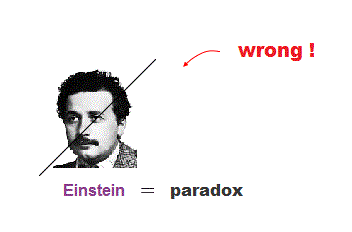
Home page
Einstein is false.
Twin paradox is real
(Fig.1) Einstein is wrong in special relativity.

Einstein relativity contradicts reality.
Though the media and universities try to deify Einstein, his relativistic theory is filled with fatal flaws, so wrong.
In fact, almost all textbooks and the media are hiding true paradoxes of Einstein reltivity so desperately that even anti-relativists don't know them.
Ordinary people should not be misled by "dummy" relativistic paradoxes such as twin paradox, which never happens within special relativity.
Here we explain one of true paradoxes of special relativity.
If the relativity includes true paradoxes, it is destroying all strudents' careers now.
It means if students and dropouts sue unievrsities for deceiving them by wrong theory, they could surely win back their money paid as tuition.
(Fig.2) Light and observer K' are moving at c and v.
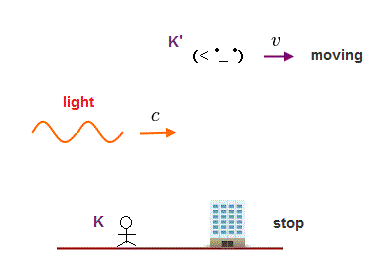
Einstein special relativity is based on Lorentz transformation.
First, we explain how this special relativity was born.
Suppose the light travels at a speed of "c", and an observer K' is moving at a speed of "v" in the same direction.
All other things such as an observer K and buildings stop.
(Fig.3) K' sees other things moving in the opposite direction.
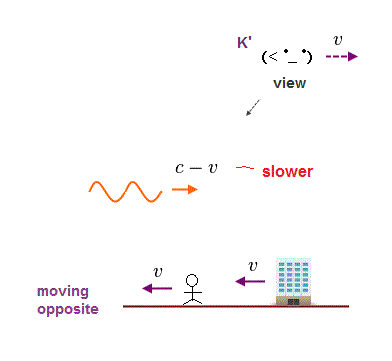
How do other things look from the viewpoint of the observer K' moving at a speed of "v" ?
Of course, all other ( stationary ) things appear to be moving in the opposite direction at "v", seen from K'.
How about the light speed c ?
The light speed c naturally appears slower to c - v instead of c, seen from K'
(Fig.4) Both moving K' and stationary K see the light traveling at "c" ?
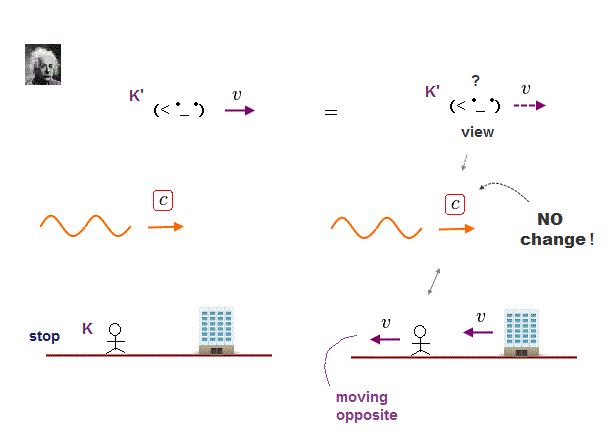
Einstein special relativity is unrealistic.
It claims the light speed always becomes "c" seen from any observers.
Even when the light speed is "c" seen from the stationary K, it appears to travel at the same speed "c" seen from the moving observer K'.
This Einstein idea is ridiculous and nonsense.
Because it's natural that relative velocity seen from an observer changes depending on the observer's velocity.
(Fig.4') Light speed appears to remain "c", Einstein claimed.
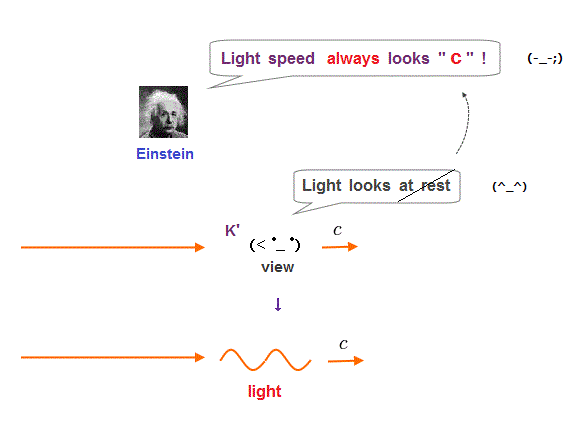
In Fig.4', the light and an observer are moving at the same speed of "c" in the same direction.
From the realistic viewpoint, this light appears to stop seen from this observer. But Einstein rejected this common sense.
He claimed even this observer sees the light moving at the same relative velocity "c", which is independent of the oberver's motion.
In fact, this Einstein's false logic was caused by misinterpreting Michelson-Morley experiment.
If we admit some "medium" moving with the earth, Einstein unrealistic relativity is unnecessary.
(Fig.5) Light is emitted from the source ( x = 0 ) at time t = 0.
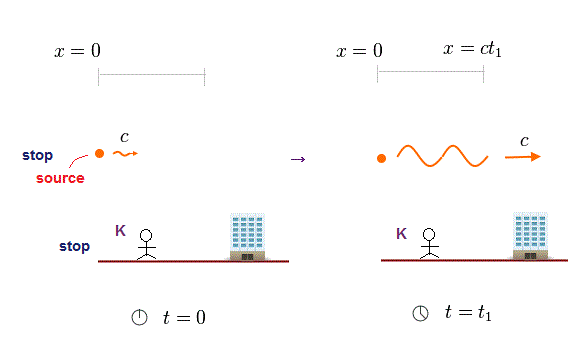
Suppose the light is emitted from its source at x = 0 at time t = 0.
The light travels at a speed of "c" seen from a stationary observer K.
After the time t1 has passed, the light wavefront arrives at x = ct1.
(Fig.6) Seen by K' moving at a speed of v, light looks slower.
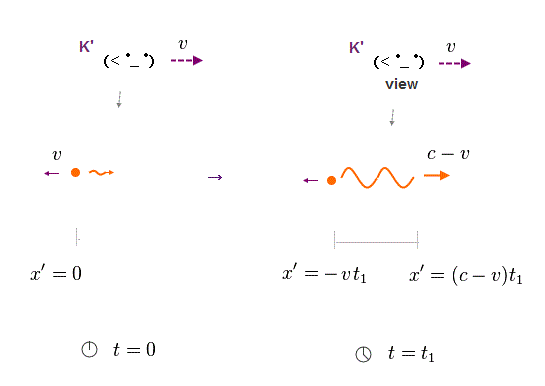
Fig.6 is a realistic case when seen from an observer K' moving at a speed "v" in the same direction.
The light head appears to travel at c - v, which is slower than "c", seen from K', because K' observer is also moving in the same direction.
The light source fixed at x = 0 is moving in the opposite direction at v, seen from K'.
(Fig.7) Clock time of K' lapses differently from clock K !?
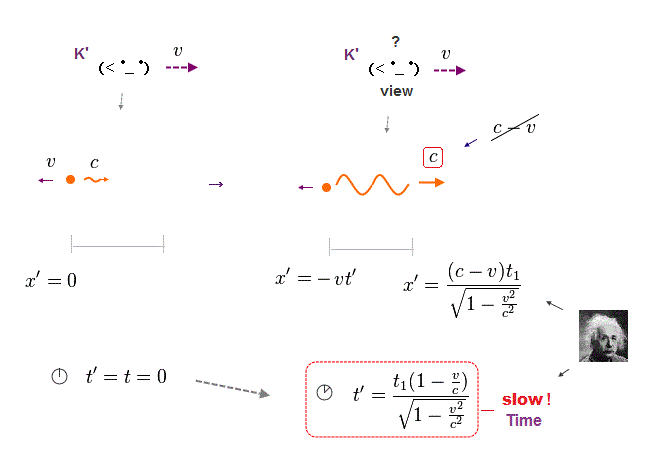
As I said, Einstein relativity adopts unrealistic idea.
Relative velocity of the light seen from any observers is always "c".
To achieve this impossible logic, we have to discard our common sense.
Einstein claimed the clock time of moving K' moves on at a different pace from stationary K !
Suppose the light is emitted from its source ( fixed at x = 0 ) at time t = t' = 0.
After time t1 has passed seen from stationary K, the clock time (= t' ) of moving K' becomes different (= slower ) from t1 !
So in Einstein relativity, the time (= t' ) and space (= x' ) in different observers change in a completely different way ! This is ridiculous.
(Fig.8) The light speed seen from the moving K' remains "c" ?
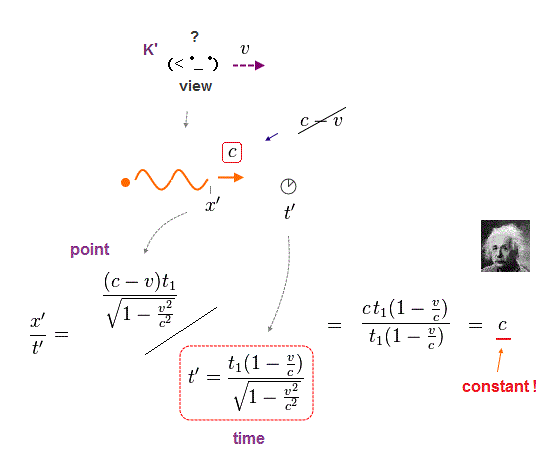
According to Einstein relativity, the position (= x' ) and the clock time (= t' ) at the light wavefront become distorted, seen from the moving observer K'.
Dividing the point coordinate of the light head by the clock time, you find the relative light speed remains "c" (= x'/t' ).
This absurd logic is Einstein relativity.
(Fig.9) Spacetimes in stationary (= t, x ) and moving (= t', x' ) observers
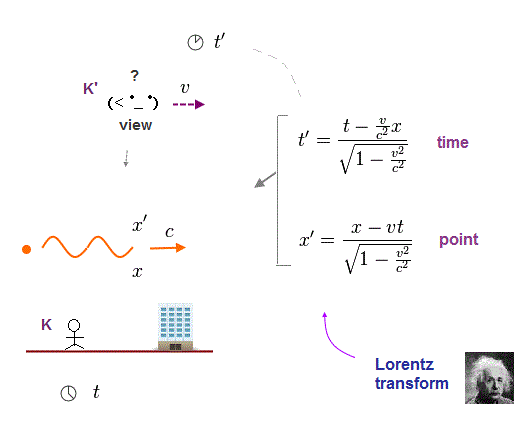
This change in Einstein's spacetime depending on observer's motion obeys Lorentz transformation.
The space coordinate (= x ) and the clock time (= t ) seen from stationary K observer.
The space coordinate (= x' ) and the clock time (= t' ) seen from K' observer moving at v in x direction.
This strange world is Einstein relativity.

2016/2/26 updated. Feel free to link to this site.